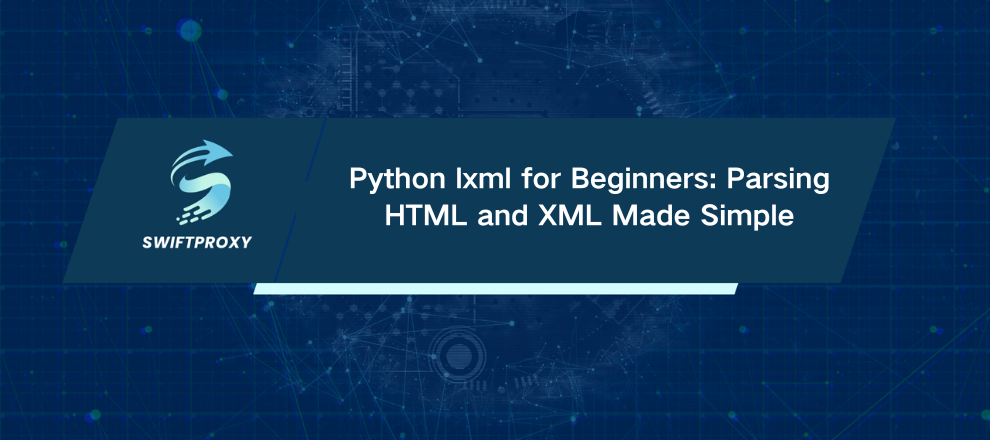Python lxml for Beginners: Parsing HTML and XML Made Simple

Parsing HTML and XML isn't just another task—it's a gateway to unlocking vast data hidden in websites and files. Python's lxml library is your secret weapon here. It's lightning-fast and packed with features that make parsing complex documents feel surprisingly easy.
Whether you're diving into web scraping or wrangling XML configurations behind the scenes, mastering python lxml will save you hours—and headaches. This guide walks you through installing, parsing, and extracting data with lxml's powerful tools. Ready to power up your Python scraping game? Let's jump in.
What Makes lxml the Go-To Library
lxml pairs Python's clean, intuitive API with blazing C speed underneath. Built on the battle-tested libxml2 and libxslt libraries, it handles huge files and messy HTML with ease. It's not just fast—it's smart.
Why choose lxml over alternatives?
Speed that scales: Parsing hundreds or thousands of pages? lxml's C core means it keeps pace where pure Python parsers drag.
Feature-rich: Full XPath 1.0 support, XSLT transforms, and XML schema validation are baked in. Basic libraries can't compete.
Flexible parsing: Well-formed XML or real-world, messy HTML—lxml handles both without fuss.
Bottom line? When you need reliable speed and power, lxml hits the sweet spot between ease of use and performance. No wonder it's behind the scenes in tools like Scrapy and BeautifulSoup.
Installing lxml
Grab lxml with pip. Open your terminal and run:
pip install lxml
Windows users: Usually no sweat—pip pulls precompiled wheels. Keep pip updated to avoid headaches.
Linux: You might need development headers like libxml2-dev and libxslt-dev. On Ubuntu/Debian:
sudo apt-get install libxml2-dev libxslt-dev python3-dev
macOS: If you hit a snag (especially on M1/M2), install Xcode Command Line Tools:
xcode-select --install
Conda fans can also do:
conda install lxml
After install, test it:
>>> import lxml
>>> from lxml import etree
>>> print(lxml.__version__)
If no errors pop and a version prints, you're golden.
Parsing Your First XML
Parsing XML is straightforward. Here's a snippet that breaks it down:
from lxml import etree
xml_data = "<root><child>Hello</child></root>"
root = etree.fromstring(xml_data)
print(root.tag) # outputs: root
print(root[0].tag) # outputs: child
print(root[0].text) # outputs: Hello
What's happening?
etree.fromstring() converts the XML string into a tree of Elements.
You can access children like list items (root[0]).
Each element exposes .tag for the tag name and .text for inner text.
This sets the stage for parsing real files and web content.
Building and Modifying XML with Ease
lxml doesn't just read XML—it creates and manipulates it effortlessly. Want to build an XML document from scratch? Check this out:
from lxml import etree
root = etree.Element("books")
book1 = etree.SubElement(root, "book")
book1.text = "Clean Code"
book1.set("id", "101")
book2 = etree.SubElement(root, "book")
book2.text = "Introduction to Algorithms"
book2.set("id", "102")
print(etree.tostring(root, pretty_print=True, encoding='unicode'))
This spits out:
<books>
<book id="101">Clean Code</book>
<book id="102">Introduction to Algorithms</book>
</books>
This approach is perfect for generating config files, reports, or any XML you want to build programmatically.
Parsing HTML or XML
Real-world HTML isn't always neat and tidy. Tags get left open, nesting breaks. That's where lxml's HTML parser shines.
For strict XML, use:
etree.parse("file.xml")
For messy HTML, use:
from lxml import html
doc = html.fromstring(html_string)
lxml's html module is built to handle quirks, fixes broken markup, and builds a usable DOM so you can extract info without drama.
Unlock the Power of XPath and CSS Selectors
Data extraction is where lxml truly shines. XPath is a query language tailor-made for navigating XML/HTML trees. Use it to zero in on exactly what you want:
# Grab all links inside nav elements
links = doc.xpath('//nav//a/@href')
texts = doc.xpath('//nav//a/text()')
Why XPath? Because it's precise and fast:
// means “search anywhere below this node”
[@class="foo"] filters elements by attribute
You can combine conditions and functions to drill down complex structures.
Prefer CSS selectors? Some libraries wrap lxml for that, but XPath is more powerful and directly supported.
Real-World Example
import requests
from lxml import html
url = "http://books.toscrape.com/"
response = requests.get(url)
doc = html.fromstring(response.content)
books = []
for book in doc.xpath('//article[@class="product_pod"]'):
title = book.xpath('.//h3/a/@title')[0]
price = book.xpath('.//p[@class="price_color"]/text()')[0]
books.append({"title": title, "price": price})
print(books)
Final Thoughts
Mastering lxml means having a fast, flexible, and powerful parsing tool at your fingertips. Whether you're parsing XML from scratch or tackling complex web structures, lxml makes it easy. Remember, real progress comes from practice—try out the example code above and explore more XPath and HTML parsing techniques.
Note sur l'auteur

Parsing HTML and XML isn't just another task—it's a gateway to unlocking vast data hidden in websites and files. Python's lxml library is your secret weapon here. It's lightning-fast and packed with features that make parsing complex documents feel surprisingly easy.
Whether you're diving into web scraping or wrangling XML configurations behind the scenes, mastering python lxml will save you hours—and headaches. This guide walks you through installing, parsing, and extracting data with lxml's powerful tools. Ready to power up your Python scraping game? Let's jump in.
What Makes lxml the Go-To Library
lxml pairs Python's clean, intuitive API with blazing C speed underneath. Built on the battle-tested libxml2 and libxslt libraries, it handles huge files and messy HTML with ease. It's not just fast—it's smart.
Why choose lxml over alternatives?
Speed that scales: Parsing hundreds or thousands of pages? lxml's C core means it keeps pace where pure Python parsers drag.
Feature-rich: Full XPath 1.0 support, XSLT transforms, and XML schema validation are baked in. Basic libraries can't compete.
Flexible parsing: Well-formed XML or real-world, messy HTML—lxml handles both without fuss.
Bottom line? When you need reliable speed and power, lxml hits the sweet spot between ease of use and performance. No wonder it's behind the scenes in tools like Scrapy and BeautifulSoup.
Installing lxml
Grab lxml with pip. Open your terminal and run:
pip install lxml
Windows users: Usually no sweat—pip pulls precompiled wheels. Keep pip updated to avoid headaches.
Linux: You might need development headers like libxml2-dev and libxslt-dev. On Ubuntu/Debian:
sudo apt-get install libxml2-dev libxslt-dev python3-dev
macOS: If you hit a snag (especially on M1/M2), install Xcode Command Line Tools:
xcode-select --install
Conda fans can also do:
conda install lxml
After install, test it:
>>> import lxml
>>> from lxml import etree
>>> print(lxml.__version__)
If no errors pop and a version prints, you're golden.
Parsing Your First XML
Parsing XML is straightforward. Here's a snippet that breaks it down:
from lxml import etree
xml_data = "<root><child>Hello</child></root>"
root = etree.fromstring(xml_data)
print(root.tag) # outputs: root
print(root[0].tag) # outputs: child
print(root[0].text) # outputs: Hello
What's happening?
etree.fromstring() converts the XML string into a tree of Elements.
You can access children like list items (root[0]).
Each element exposes .tag for the tag name and .text for inner text.
This sets the stage for parsing real files and web content.
Building and Modifying XML with Ease
lxml doesn't just read XML—it creates and manipulates it effortlessly. Want to build an XML document from scratch? Check this out:
from lxml import etree
root = etree.Element("books")
book1 = etree.SubElement(root, "book")
book1.text = "Clean Code"
book1.set("id", "101")
book2 = etree.SubElement(root, "book")
book2.text = "Introduction to Algorithms"
book2.set("id", "102")
print(etree.tostring(root, pretty_print=True, encoding='unicode'))
This spits out:
<books>
<book id="101">Clean Code</book>
<book id="102">Introduction to Algorithms</book>
</books>
This approach is perfect for generating config files, reports, or any XML you want to build programmatically.
Parsing HTML or XML
Real-world HTML isn't always neat and tidy. Tags get left open, nesting breaks. That's where lxml's HTML parser shines.
For strict XML, use:
etree.parse("file.xml")
For messy HTML, use:
from lxml import html
doc = html.fromstring(html_string)
lxml's html module is built to handle quirks, fixes broken markup, and builds a usable DOM so you can extract info without drama.
Unlock the Power of XPath and CSS Selectors
Data extraction is where lxml truly shines. XPath is a query language tailor-made for navigating XML/HTML trees. Use it to zero in on exactly what you want:
# Grab all links inside nav elements
links = doc.xpath('//nav//a/@href')
texts = doc.xpath('//nav//a/text()')
Why XPath? Because it's precise and fast:
// means “search anywhere below this node”
[@class="foo"] filters elements by attribute
You can combine conditions and functions to drill down complex structures.
Prefer CSS selectors? Some libraries wrap lxml for that, but XPath is more powerful and directly supported.
Real-World Example
import requests
from lxml import html
url = "http://books.toscrape.com/"
response = requests.get(url)
doc = html.fromstring(response.content)
books = []
for book in doc.xpath('//article[@class="product_pod"]'):
title = book.xpath('.//h3/a/@title')[0]
price = book.xpath('.//p[@class="price_color"]/text()')[0]
books.append({"title": title, "price": price})
print(books)
Final Thoughts
Mastering lxml means having a fast, flexible, and powerful parsing tool at your fingertips. Whether you're parsing XML from scratch or tackling complex web structures, lxml makes it easy. Remember, real progress comes from practice—try out the example code above and explore more XPath and HTML parsing techniques.


















































